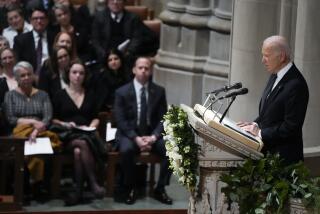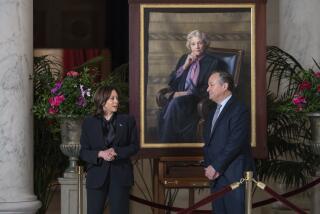The Invisible Bar: THE WOMAN LAWYER IN AMERICA 1638-1986 by Karen Berger Morello (Random House: $19.95; 352 pp., illustrated)
- Share via
You women lawyers who think you’ve “come a long way,” think again. Karen Berger Morello’s “The Invisible Bar,” calling itself the first history of the woman lawyer in America, chronicles the struggles past and present of female pioneers in a male-dominated profession that has used many means to thwart the brave and persistent efforts of black slaves, suffragists, wives, daughters, proper ladies and immigrants to become professional jurists.
The author began her study as the historian of a county women’s bar association in New York City. She is a lawyer with the Metropolitan Assistance Corp. in that city. In collecting photographs and stories for a 50th-anniversary date book for that local organization, she discovered that women had been practicing law in the United States for more than 100 years without a written history. Morello decided to broaden her historical inquiry to include the tales of struggle, discrimination and fortitude of the first women lawyers, law students, trial lawyers, social reformers, law-firm lawyers and judges so that women attorneys will “know their past and understand that the struggle for equality is nowhere near completion.”
History comes to life in this delightful and entertaining, if sobering, story, through the anecdotes, interviews and experiences of dozens of the nation’s first legal professionals. Morello begins by telling us that the first woman to act as a lawyer in the United States was probably Margaret Brent, who, in getting herself appointed as counsel to the governor of the colony of Maryland in the mid-17th Century, was called “Gentleman Margaret Brent” by clients who didn’t know what else to call such a powerful woman. Another early woman attorney was slave Elizabeth Freeman, who successfully argued for her own freedom in 1783 in a Massachusetts court. Morello chronicles the better-known struggles of Myra Bradwell, denied admission to the bar by the United States Supreme Court in 1873, and our own Clara Foltz who was the first woman admitted to the bar in California and who sued the Hastings College of Law for admission.
In separate chapters, Morello gives us the first women lawyers in each of the states, the first law students in the more liberal frontier West, the urban East and the least receptive Ivy League, and the contributions of the first group of social reformers who used law to attempt to vote, enact progressive labor and child-protective legislation and to challenge the male hegemony of legal power. Morello does better than most social historians by recounting the stories of the first black women lawyers and the particularly difficult and courageous history of Lyda Conley, the first native American woman lawyer who fought to keep her tribe’s burial ground. Her stories of the first women courtroom lawyers, large law-firm lawyers and judges are kept lively with contemporaneous accounts from the newspaper reports of days past and of interviews from days present with famous women jurists like Carla Hills, Rose Bird and Sandra Day O’Connor.
Lawyers and lay people alike will be dismayed to learn of the sexist and bigoted views held by some of our leading legal lights: Clarence Darrow (who thought women were too kind), Harlan Fiske Stone, Erwin Griswold and Thurman Arnold (who did not want to admit women to the Columbia Law School, Harvard Law School and the Anti-trust division of the Justice Department, respectively) and even Felix Frankfurter (who, writing that states could legislate to keep the sexes in different occupations, sustained a law that prevented women from being bartenders).
“The Invisible Bar” will be good reading both for legal historians and for lawyers, both male and female, who seek to understand whence they have come. If it falls a bit short in the very brief treatment given to so many colorful figures, it is nonetheless lively and personal enough to inspire some full-length biographies of our female legal pioneers.
Most important, Morello begins to explore, even if she can’t answer, the questions that interest us most. Will women make a distinct contribution to the practice and making of law (by working harder for social-reform issues, for example)? Does the sheer increase in numbers of women law students, lawyers and judges mean equality in the legal profession has arrived? (She thinks not.) Will our younger sisters understand how difficult and unfinished this struggle is, or do they think the road to yuppified success in the law firm is now clear? “The Invisible Bar,” in all its variety, becomes more visible each year--by the year 2000, half our lawyers will be women. This delightful book illuminates our past as we contemplate our future.
More to Read
Sign up for our Book Club newsletter
Get the latest news, events and more from the Los Angeles Times Book Club, and help us get L.A. reading and talking.
You may occasionally receive promotional content from the Los Angeles Times.









